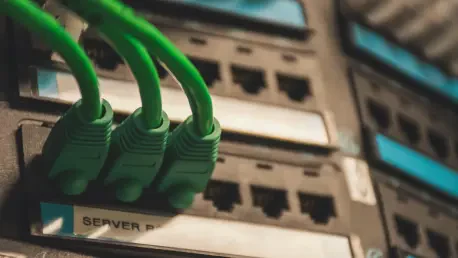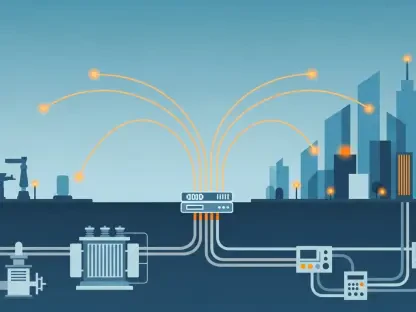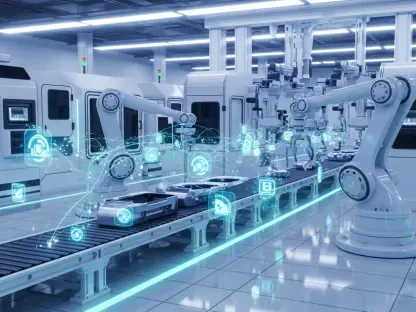In an age where technology transforms every facet of industry, non-road equipment like agricultural tractors and construction machinery has evolved far beyond mere mechanical tools into sophisticated, connected systems that thrive on automation and real-time data exchange. These advancements, while boosting efficiency and productivity, introduce a significant challenge: the urgent need for robust cybersecurity. As these machines generate, transmit, and store vast amounts of sensitive information—ranging from GPS coordinates to diagnostic reports—they become prime targets for cyber threats that could disrupt operations, compromise safety, or lead to substantial financial losses. The stakes couldn’t be higher for manufacturers, dealers, and equipment owners who must navigate this complex landscape. This article delves into the escalating risks associated with connected equipment, examines industry-led initiatives to counter these threats, and explores actionable strategies to ensure security in an increasingly digital environment.
Escalating Cyber Threats in a Digital Landscape
The rapid integration of connectivity into non-road equipment has dramatically heightened cybersecurity risks, creating a pressing need for vigilance across the industry. As machinery becomes more interconnected through advanced sensors and data networks, the potential for unauthorized access to critical information grows exponentially. A breach in these systems could have dire consequences, including compromised safety protocols, stolen proprietary data, or halted operations that ripple through supply chains. Industry experts underscore that the integrity of machine data is no longer just a technical concern but a fundamental business risk that demands immediate attention. The sheer volume of data handled by modern equipment, often in real-time, amplifies the threat surface, making it imperative to develop robust defenses against malicious actors who seek to exploit vulnerabilities for gain or disruption.
Beyond the volume of data, the variety and locations of information add layers of complexity to securing non-road equipment in a connected era. Data types range from operational metrics like engine performance to specialized agronomic insights in farming machinery, each carrying unique value and risks. This information exists at multiple stages—stored on the machine itself, transmitted across networks, or housed in off-machine servers—each presenting distinct challenges. For instance, on-machine data might be vulnerable to physical tampering, while data in transit risks interception if not encrypted properly. Off-machine storage, often in cloud environments, could face unauthorized access if robust controls are absent. Addressing these multifaceted threats requires a nuanced approach that accounts for the diverse nature of data and its lifecycle, ensuring that protective measures are both comprehensive and tailored to specific points of vulnerability.
Building a Unified Defense Through Collaboration
To confront the mounting cybersecurity challenges, the industry has rallied around collaborative efforts, with the Association of Equipment Manufacturers (AEM) leading the charge through a pivotal guidance document titled Cybersecurity for Machine Data for Non-Road Equipment. Crafted with input from stakeholders in agriculture and construction, this resource avoids rigid mandates and instead focuses on creating a shared language and framework for protecting data across its lifecycle. The emphasis is on fostering dialogue among manufacturers, service providers, and end-users to ensure everyone understands their role in maintaining security. By prioritizing a collective approach, the guidance helps align disparate parties under a common goal of safeguarding connected machinery without hampering technological progress or operational flexibility, which remains crucial for innovation in the sector.
A core component of this collaborative framework is the focus on permissions-based access control to limit who can interact with sensitive machine data at various touchpoints. This means ensuring that only authorized individuals—whether operators on the ground, original equipment manufacturers (OEMs) monitoring systems, or third-party technicians—can access specific information. The guidance establishes clear expectations for authentication protocols, reducing the likelihood of unauthorized breaches that could compromise equipment functionality or safety. Additionally, by promoting transparency among stakeholders, the framework encourages proactive measures like regular security audits and updates, which are essential for staying ahead of evolving threats. This unified stance not only strengthens defenses but also builds trust across the industry, ensuring that all parties are equipped to handle the complexities of a connected ecosystem.
Clarifying Responsibilities Across Stakeholders
Understanding and delineating responsibilities is a cornerstone of securing non-road equipment, as the multi-stakeholder environment often leads to ambiguity without clear guidelines. AEM’s guidance tackles this head-on by mapping out specific roles at each stage of the data lifecycle, ensuring accountability. For instance, OEMs bear the primary responsibility for securing on-machine systems through timely software patches and firmware updates that address known vulnerabilities. Meanwhile, platform providers managing off-machine data storage are tasked with implementing robust recovery mechanisms and safeguarding cloud-based systems against unauthorized access. This structured division of duties helps eliminate gaps in security coverage, providing a seamless defense strategy that spans from the equipment itself to external data repositories.
Equally important is the empowerment of end-users and service providers within this responsibility framework, as their actions directly impact overall security. End-users, often the first line of defense, must be educated on best practices such as recognizing phishing attempts or adhering to access protocols to prevent accidental breaches. Service providers, on the other hand, play a critical role in maintaining secure data transfers during maintenance or diagnostics, ensuring that no weak links compromise the chain. By clearly defining these roles, the industry fosters a culture of proactive planning where each stakeholder understands their contribution to detecting, mitigating, and recovering from cyber incidents. This clarity not only enhances response times during threats but also builds a resilient network of accountability that is vital for long-term security in a connected landscape.
Tailoring Security to Diverse Needs and Risks
The diversity of non-road equipment means that cybersecurity solutions cannot follow a one-size-fits-all model, as risks vary widely depending on the type of machinery and its operational context. A basic piece of equipment like a field rake, for example, faces far fewer threats compared to a high-tech tractor loaded with sensors and connectivity features that handle sensitive data. Similarly, the nature of vulnerabilities shifts across data stages: on-machine systems risk safety issues from unauthorized firmware, data in transit could be intercepted if channels are unsecured, and off-machine storage might suffer from inadequate access controls leading to manipulation. Recognizing these disparities, the industry advocates for flexible security measures within a unified framework, allowing stakeholders to customize protections based on specific equipment needs and threat profiles.
This adaptability is crucial as cyber threats continue to evolve, often outpacing static defenses with new tactics and exploits. By emphasizing tailored solutions, the approach ensures that security protocols remain relevant and effective against emerging risks, whether they target complex agricultural combines or rugged construction excavators. Stakeholders are encouraged to assess their unique environments and implement measures like enhanced encryption for data transfers or multi-factor authentication for system access, depending on the assessed risk level. This balance of customization and standardization helps maintain operational efficiency while addressing the distinct challenges posed by different equipment types. Ultimately, such a strategy equips the industry to stay nimble, ensuring that security evolves in step with both technological advancements and the sophisticated threats of a connected era.
Paving the Way for a Secure Future
Reflecting on the journey to secure non-road equipment, it’s evident that the industry has taken significant strides by acknowledging the profound risks introduced by connectivity and responding with structured, collaborative efforts. The development of AEM’s guidance document marked a turning point, providing a foundation for standardized practices while allowing flexibility to address diverse needs. Stakeholders across the board, from OEMs to end-users, have embraced shared responsibility, ensuring that every stage of the data lifecycle is fortified against potential breaches. These efforts have laid the groundwork for a resilient framework that prioritizes education and proactive planning.
Looking ahead, the focus should shift to continuous improvement and innovation in cybersecurity measures. Stakeholders are encouraged to invest in regular training programs to keep pace with emerging threats and to adopt cutting-edge technologies like artificial intelligence for threat detection. Strengthening partnerships with regulatory bodies and aligning with global standards will further enhance credibility and effectiveness. By maintaining this momentum, the industry can build on past achievements, ensuring that non-road equipment remains secure against the ever-changing landscape of cyber risks.









